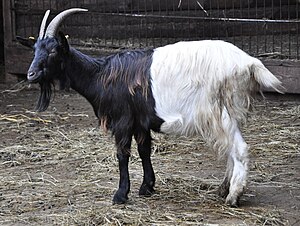Valais Blackneck
 | |
| Conservation status | FAO (2007): Italy: critical[1] other countries: not listed |
|---|---|
| Other names |
|
| Country of origin | |
| Distribution | mainly in the Valais |
| Standard | |
| Use | meat, milk, vegetation management |
| Traits | |
| Weight | |
| Height | |
| Skin color | often pale |
| Wool color | black foreparts, white hindparts |
| Face color | black |
| Horn status | horned in both sexes |
| |


The Valais Blackneck is a breed of domestic goat from the canton of Valais, in southern Switzerland, and neighbouring areas of northern Italy. The largest concentration is in the area of Visp (Viège). It is present in modest numbers in Austria and Germany. It is known by many names, including Template:Lang-de or Gletschergeiss; Template:Lang-fr, Chèvre des Glaciers or Race de Viège; and Template:Lang-it or Vallese.
The Valais Blackneck has a distinctive colouring, black from the nose to behind the shoulder and white from there to the tail. The English Bagot goat, which is similarly coloured, is thought to derive from this breed by descent from one presented to Richard II of England in 1380.[7]
Within Italy, the Vallesana is raised in the provinces of Verbania and Vercelli.[8] It is one of the forty-three autochthonous Italian goat breeds of limited distribution for which a herdbook is kept by the Associazione Nazionale della Pastorizia, the Italian national association of sheep- and goat-breeders.[9][10]
At the end of 2013 the total numbers for the breed were 3000–3400 in Switzerland and either 191[11] or 446[5] in Italy. In 2012 Austria reported 100–300 head[3] and Germany 429.[4]
References
- ^ Barbara Rischkowsky, D. Pilling (eds.) (2007). List of breeds documented in the Global Databank for Animal Genetic Resources, annex to The State of the World’s Animal Genetic Resources for Food and Agriculture. Rome: Food and Agriculture Organization of the United Nations. ISBN 9789251057629. Accessed June 2014.
- ^ Breed data sheet: Walliser Schwarzhalsziege/Switzerland. Domestic Animal Diversity Information System of the Food and Agriculture Organization of the United Nations. Accessed June 2014.
- ^ a b Breed data sheet: Walliser Schwarzhalsziege/Austria. Domestic Animal Diversity Information System of the Food and Agriculture Organization of the United Nations. Accessed June 2014.
- ^ a b Breed data sheet: Walliser Schwarzhalsziege/Germany. Domestic Animal Diversity Information System of the Food and Agriculture Organization of the United Nations. Accessed June 2014.
- ^ a b Breed data sheet: Vallesana/Italy. Domestic Animal Diversity Information System of the Food and Agriculture Organization of the United Nations. Accessed June 2014.
- ^ a b c d Walliser Schwarzhaslziege (in German). Oberwalliser Ziegenzuchtverband. Accessed June 2014.
- ^ Daniele Bigi, Alessio Zanon (2008). Atlante delle razze autoctone: Bovini, equini, ovicaprini, suini allevati in Italia (in Italian). Milan: Edagricole. ISBN 9788850652594. p. 420–21.
- ^ Norme tecniche della popolazione caprina "Capra Vallesana": standard della razza (in Italian). Associazione Nazionale della Pastorizia. Accessed June 2014.
- ^ Strutture Zootecniche (Dec. 2009/712/CE - Allegato 2 - Capitolo 2) (in Italian). Ministero delle Politiche Agricole Alimentari e Forestali. Section I (e). Archived 4 December 2013.
- ^ Le razze ovine e caprine in Italia (in Italian). Associazione Nazionale della Pastorizia: Ufficio centrale libri genealogici e registri anagrafici razze ovine e caprine. p. 113. Accessed May 2014.
- ^ Consistenze Provinciali della Razza 92 Vallesana Anno 2013 (in Italian). Associazione Nazionale della Pastorizia: Banca dati. Accessed June 2014.
